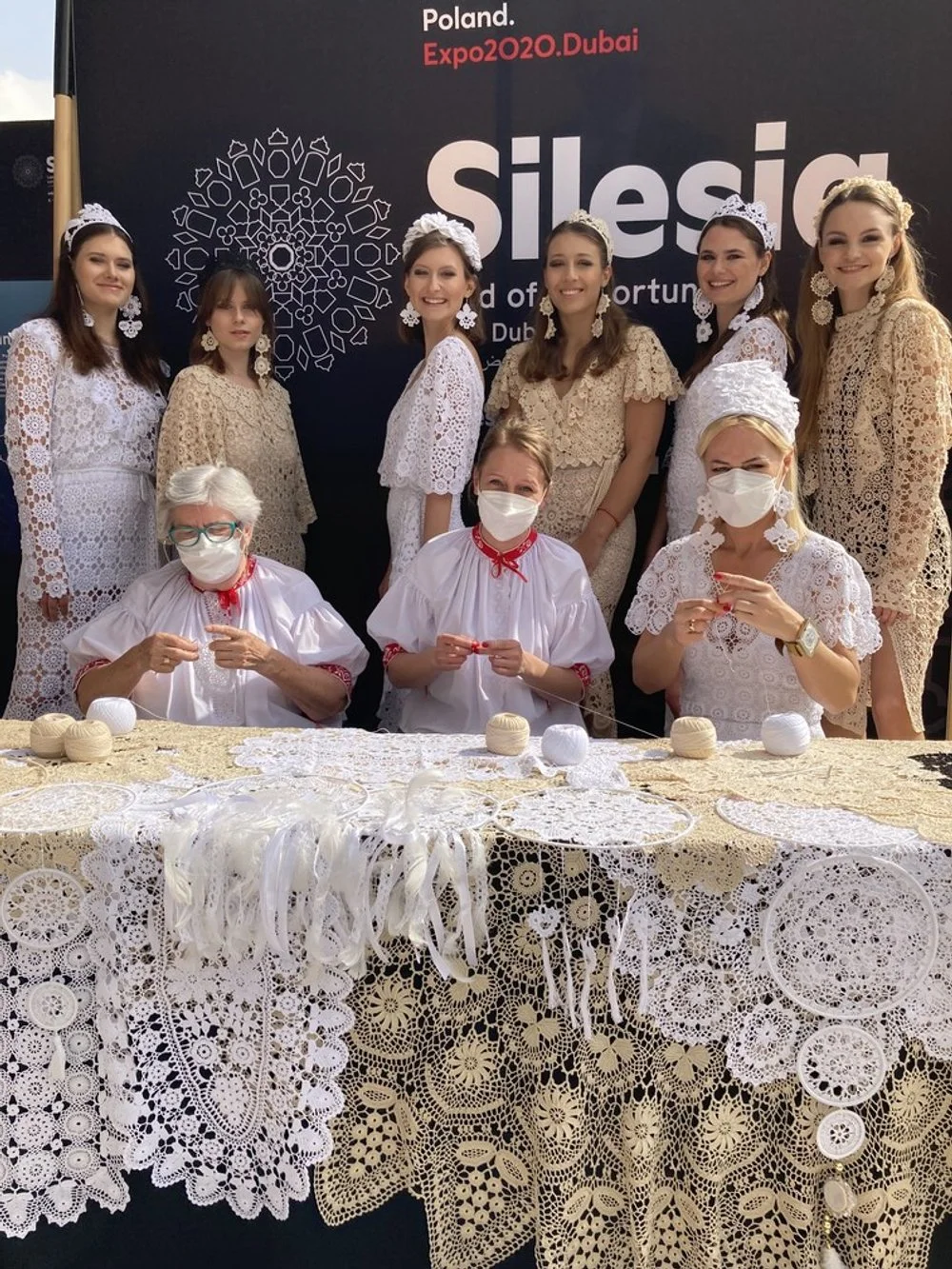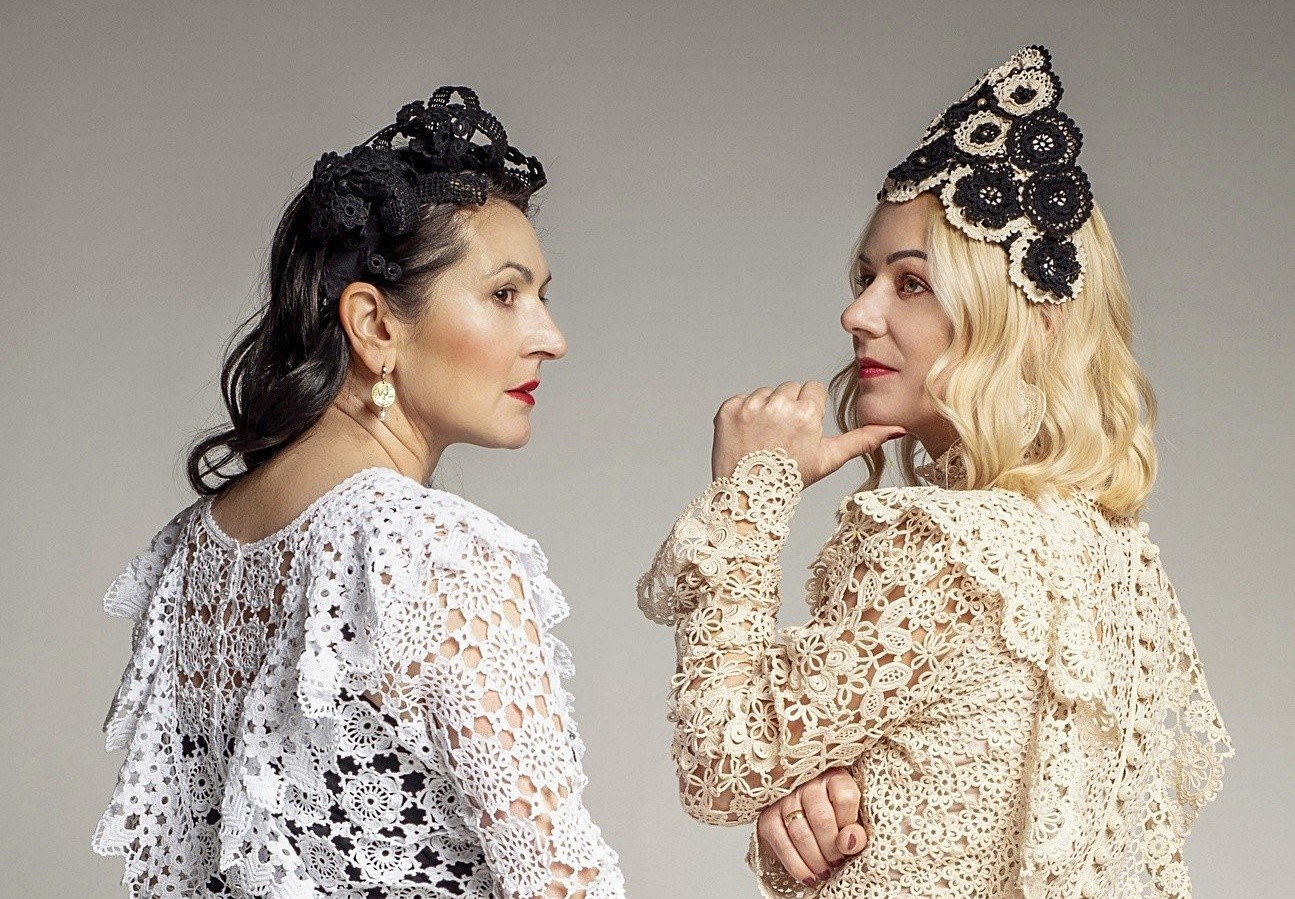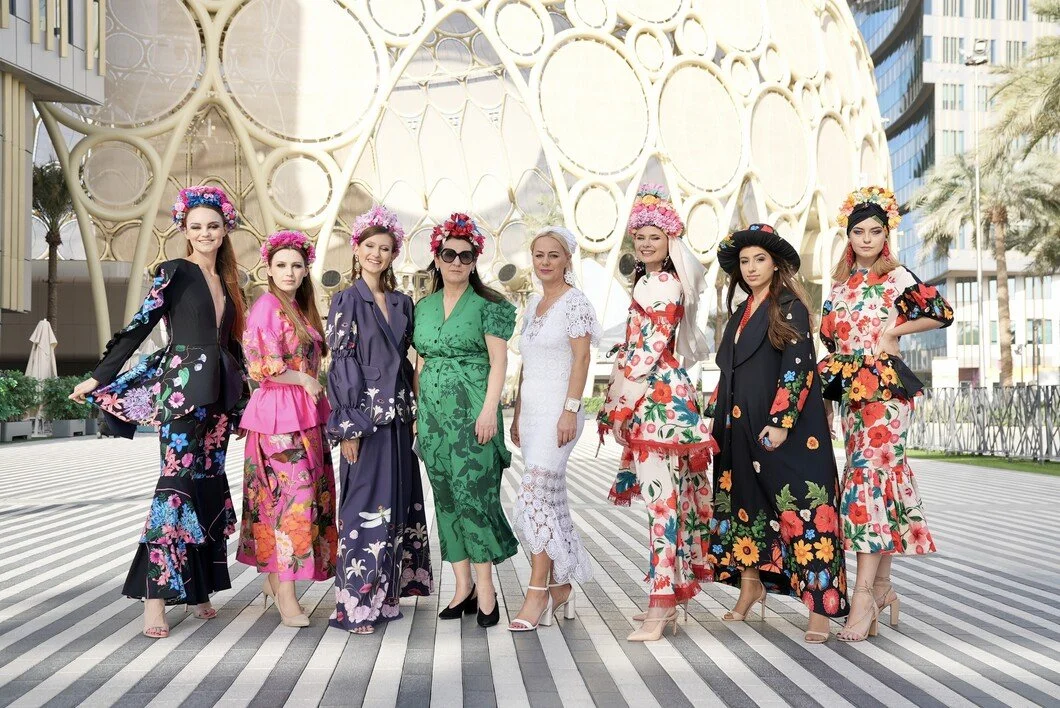Meet the head of Polish cultural center Lucyna Ligocka- Kohut
The village of Koniaków is surrounded by two legendary mountains - Ochodzita and Koczy Zamek. The nostrils are filled here with the crisp scent of the forest, and the sounds of mountain streams burble in the ears. Koniaków belongs to the so-called Beskid Trivillage, which also includes Jaworzynka and Istebna. Each of these places is a jewel of the region and each of them has an international dimension.
Jaworzynka is known all over the world for its Museum and Gene Bank of extremely durable and tall spruce. In Istebna there is the Memorial Chamber of Jerzy Kukuczka, considered one of the most remarkable alpine and high-altitude climbers. Koniaków developed a unique method of lace-making with no ready patterns or templates - each garment made with Koniaków lace is unique.
Over 700 lacemakers have cultivated the traditions of lace designer Zuzanna Wałach for over a hundred years. Today, their unusual projects gain publicity thanks to Lucyna Ligocka-Kohut, the founder of the Koronki Koniakowskie foundation and the Koniaków Lace Center. Her visionary mind, impressive knowledge, ambition, entrepreneurship, and organizational skills took Koniaków lace all over the world.
Koniaków lace has on its account a Guinness record, participation in one of the Discovery Channel programs, Fashion Week and Victoria's Secret shows in Paris, cooperation with fashion houses such as Dior and Louis Vuitton, and an exhibition at the Expo 2020 in Dubai.
Expo 2020 Dubai
The Polish Pavilion has presented: the record-breaking Koniaków doily with an impressive diameter of 5.3 meters, a collection of 20 lace dresses made of MUZA 50 cordon and 10,000 gifts/accessories designed by 150 lacemakers.
In the preparation for the show was involved Beata Bojda, a costume designer who draws inspiration from Polish folklore.
Why does Koniaków lace evoke emotions and attract so many people around the world? It begins with the story of Lucyna Ligocka-Kohut and the extraordinary community of women from Koniaków.
Lucyna was born in Cieszyn and settled in Istebna. Lace has always been a part of her life, having grown up watching her Grandmother from Koniaków make lace. As a teenager, Lucyna was not aware of how unique this experience is. However, her perspective changed when she saw more of the world during her studies.
“I chose to study anthropology and ethnography, due to the fact that I am a Goral - a Polish Highlander who lives in a village that is so ethnographically interesting. This is how I deepened my knowledge about my homeland."
In time, Lucyna started working in a cultural center where she developed her first lace projects. Later, she helped publish a book, helped her local lacemakers organize and achieve a Guinness world record, and participated in exhibitions and festivals around the world.
“It was a time when I discovered the enormous potential and artistic value of Koniaków lace. We were the only representatives of crochet lace, which is characterized by an extraordinary variety, a multitude of motifs and compositions. What arouses admiration all over the world is the complexity of our lace, as well as the fact that our lacemakers create without the templates. It just happens very naturally here."
The uniqueness of the Koniaków lace technique is also due to the strong ties of the community. It cannot be learned. You have to feel it and cultivate it every day. The lace is the cause of meetings, discussions, and development. The women of Koniaków work together for their success.
"The energy that I received from people, as well as the awareness of how unique a phenomenon it is, made me become even more involved in lace promoting".
The first records of Koniaków lace in the form of mobcaps date back to 1883/84, but the original technique is unknown. In the case of doilies, it was 1906/1907, and their origins are associated with Zuzanna Wałach. One story says that Zuzanna saw lace napkins while on duty in Goleszów. In 1913, she married Paweł Golik and moved to Koniaków. She presented doilies to local women and started selling them in an inn in Wisła town. In 1947, her neighbor, Maria Gwarek, founded the Cepelia (Polish Art And Handicraft Foundation) in Koniaków, which employed lacemakers for the next 50 years, paid fees, and organized exhibitions and competitions for inventing new patterns. This made lace-making a profession in Koniaków. When Zuzanna Gwarek, the leader of the Memorial Chamber of Maria Gwarek, died, the duties of promoting the lace-making tradition passed to Lucyna.
The turning point in Lucyna's career was the collaboration with the Japanese designer Rei Kawakubo, who incorporated Koniaków lace in her wedding dress presented at Paris Fashion Week. Lucyna realized that this type of cooperation could be a new direction in the development of lacemaking, which, apart from maintaining the cultural heritage, would have business value.
"Sales and appreciation from customers are a big drive for our lacemakers. It gives them self-confidence and allows us to invest in new activities."
The year 2018 entered a special period in Lucyna's life due to her pregnancy and decision to change her career plans. At that time, Lucyna opened a foundation and bought a house, where she founded the Koniaków Lace Center in 2019.
“I was on my way to the Memorial Chamber of Maria Gwarek, when I saw a banner on the building informing that it was for sale. I thought that it was a good sign. "
In time, Lucyna quit her full-time job and completely focused on promoting lace. Today, her impressive portfolio includes over 25 projects implemented with the support and financing of the International Visegrad Fund, the Ministry of Culture, the Marshal's Office, and the European Fund. Currently, her scope of activities includes cooperation with institutions, media, designers, and TV.
In the interview below, she answered a few additional questions that are part of my research on clothing from different cultures.
What is your definition of fashion?
Fashion means wearing clothes that reflect our personality.
Fashion has been with me since I was a child because my mother and both grandmothers are seamstresses, and grandma who comes from Koniaków is a lacemaker. In our house, we had a sewing machine, needles, threads, scraps of fabrics, and fashion catalogs from which we drew our inspiration. While working in a cultural center, I got involved in organizing fashion shows to inspire women how to dress well, love their own style, and experiment.
Searching for your own aesthetics is an interesting adventure. I like to watch fashion shows or catalogs to open my mind and check what resonates with me. When one’s style is defined, you do not blindly follow trends, but selectively choose what suits you.
If you could describe Koniaków Lace in 3 words, what would they be?
Art, tradition, passion.
Why are traditional designs important for people from Koniaków?
For me, the most important thing is the lifestyle around our lace. It is unique in every aspect.
There are many women in the world who cannot find themselves in their lives, and who do not have jobs that build their self-esteem. Our lace helps us to survive difficult times, for instance when we lose jobs, when children move out, or when we don't have an idea what to do with our lives.
Lace-making is a very engaging activity that has a social dimension. Women meet, come up with new patterns, and share inspirations. They enjoy the fact that they are independent of their husbands, which increases their self-esteem. When I see their creativity and enthusiasm, I cannot imagine that this tradition would not survive.
However, I remember a moment when people from all over the world came to us, and we ran out of lace. It happened when Maria Gwarek died and the Memorial Chamber was closed. It was a time when beautiful handicraft galleries were being created in modern spaces around the world. But we, as the representatives of Koniaków lace, were behind them. That is why I decided to create a place and give people an unforgettable experience that reflects the beauty of our culture.
I still have a lot of ideas on how a lace center should look like. I know that it should be spectacular!
What is the meaning of Koniaków lace designs?
Design is the essence of the beauty of Koniaków lace. Lacemakers from all over the world are intrigued by our patterns. There is something more tha n just an aesthetic impression behind it. But let's start with the basics and talk about the colors.
Koniaków lace was traditionally made in white and cream colors, because threads of these colors used to be the most readily available. Black lace appeared sporadically on collars, and accessories. Even though nowadays threads of all colors are easily accessible, sewing with colored threads has never developed in our country. Of course, there are exceptions in fashion, e.g. the collection of underwear and dresses by Małgorzata Stanaszek, but not in the case of the doily.
Koniaków lace is also transforming into new forms of art. Doilies are more and more often framed and treated as wall decor. This growing interest in ornamental lace has also led to younger lacemakers experimenting with colors, with black lace becoming increasingly popular. However, this will not become a norm as lace-making with dark thread is more difficult and requires good eyes, restricting many older women from such lace-making. The price for the black lace is much higher because you can't work with it all day long, unlike white or cream thread.
The patterns we regard as most important are those relating to nature. The plant motifs that appear on doilies are often the plants that grow in our gardens. Women are inspired by what captivates them every day. For example, our talented lacemaker, Mrs. Zuzanna Ptak, created a pattern that symbolizes the sun coming out from behind our legendary Beskid's robber's mountain Ochodzita. She was charmed by the sight, so a motif she likes to include on her doilies is a flower surrounded by rays.
Patterns are very individual and were previously protected. Lacemakers did not want to share them until they were certified and paid for by Cepelia. Today, you can find everything on the Internet but many crocheting lace makers, who are not originally from Koniaków, have difficulty with repeating these motifs. It is so fascinating that it's so hard to copy them. What is also characteristic of our technique is composition. Each pattern is symmetrical and even countable. There is no randomness here. Lacemakers from all over the world are trying to learn our technique, but it is not an easy way. One time they redraw the processing and make it too heavy, another time they spread the motifs in the wrong way. If you want to gain our knowledge it has to be constant and systematic. It will not come naturally without being here and living our culture. That's the magic of our lace.
Do you have any legends about Koniaków lace?
Koniaków lace is a short tradition that has been developing since 1882, therefore no legends have been created yet.
However, there are more and more attempts by students to create poems or descriptions. We have several books published by the Beskidzkie Museum and Jan Kukuczka, but there is still not enough of it, which is why I was so anxious to create a place that records and archives this history. Patterns disappear with the death of lace makers, so they need to be photographed and documented. Some women come to me with napkins and laugh, "take pictures, because I'm basically going to leave here and I won't remember what I brought here."
Templates are not used in Koniaków. This is the most interesting story worth spreading about our lace.
What type of lace clothing did women use to make?
In the past, every married woman had to wear a lace mobcap. Like with today's wedding ring, it accompanied her from the wedding ceremony until the end of her life. Lacemakers who could not afford to buy a mobcap crocheted it by themselves.
Women tried to stand out, so they experimented with motives. This is how the designs developed. Until recently, we had lacemakers in our community that only made mobcaps. There are four techniques for making mobcaps - needle lace, crocheted lace, bobbin lace, and Tenerife lace. In our area, three are popular (needle, crocheted, and bobbin lace techniques).
There is a strong tradition of both clothing and music in the Beskids, which is why some women still wear mobcaps, for example during weddings, First Communions, or harvest festivals. However, today there is no problem if a married woman just makes herself a braid. In the past, this was not acceptable, because the braid was considered an attribute of attracting men and had to be hidden.
Currently, apart from mobcap, beautiful dresses are also made. You can admire them, among others at this year's Expo in Dubai.
What can the fashion industry do to be more sustainable?
I will answer this question through the prism of lace, which fits wonderfully into the idea of sustainability. These are universal values that can be applied to other designers.
First of all, we should make better use of human creations, both in design and execution. No machine. Handmade items are more valuable to us, so they stay with us longer. The ethical dimension of how production takes place is also important. In Koniaków, we make sure that lacemakers have the best conditions for development, as they are a treasure of our culture, and their well-being is reflected in the projects.
The second pillar of sustainable development is natural materials, in our case, cotton threads. Clothes made of lace are environmentally friendly, breathable, and durable. We are also very minimalist in terms of the process of manufacturing garments and doilies because the only tool that we use is the crochet hook.
The third aspect is timelessness. The crochet dress is so beautiful! It's a fashion that doesn't go out of style. This is in sharp contrast to modern “fast fashion”, which both wears out quickly and is usually disposed of after a short time. Lace can also be high fashion, as Beata Bojda is trying to prove in her collection presented in Dubai. Beata experiments with lace in a fantastic way, trying to arrange it in various ways as head and body decorations.
These three aspects: handmade, natural materials, and timelessness can make fashion more environmentally friendly.











